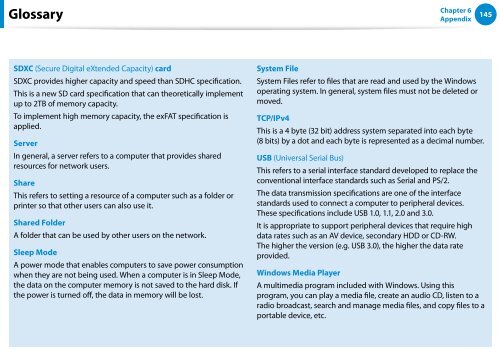Samsung Series 7 13.3” Notebook - NP740U3E-A01UB - User Manual (Windows 8) (ENGLISH)
Samsung Series 7 13.3” Notebook - NP740U3E-A01UB - User Manual (Windows 8) (ENGLISH)
Samsung Series 7 13.3” Notebook - NP740U3E-A01UB - User Manual (Windows 8) (ENGLISH)
You also want an ePaper? Increase the reach of your titles
YUMPU automatically turns print PDFs into web optimized ePapers that Google loves.
Glossary<br />
Chapter 6<br />
Appendix<br />
145<br />
SDXC (Secure Digital eXtended Capacity) card<br />
SDXC provides higher capacity and speed than SDHC specification.<br />
This is a new SD card specification that can theoretically implement<br />
up to 2TB of memory capacity.<br />
To implement high memory capacity, the exFAT specification is<br />
applied.<br />
Server<br />
In general, a server refers to a computer that provides shared<br />
resources for network users.<br />
Share<br />
This refers to setting a resource of a computer such as a folder or<br />
printer so that other users can also use it.<br />
Shared Folder<br />
A folder that can be used by other users on the network.<br />
Sleep Mode<br />
A power mode that enables computers to save power consumption<br />
when they are not being used. When a computer is in Sleep Mode,<br />
the data on the computer memory is not saved to the hard disk. If<br />
the power is turned off, the data in memory will be lost.<br />
System File<br />
System Files refer to files that are read and used by the <strong>Windows</strong><br />
operating system. In general, system files must not be deleted or<br />
moved.<br />
TCP/IPv4<br />
This is a 4 byte (32 bit) address system separated into each byte<br />
(8 bits) by a dot and each byte is represented as a decimal number.<br />
USB (Universal Serial Bus)<br />
This refers to a serial interface standard developed to replace the<br />
conventional interface standards such as Serial and PS/2.<br />
The data transmission specifications are one of the interface<br />
standards used to connect a computer to peripheral devices.<br />
These specifications include USB 1.0, 1.1, 2.0 and 3.0.<br />
It is appropriate to support peripheral devices that require high<br />
data rates such as an AV device, secondary HDD or CD-RW.<br />
The higher the version (e.g. USB 3.0), the higher the data rate<br />
provided.<br />
<strong>Windows</strong> Media Player<br />
A multimedia program included with <strong>Windows</strong>. Using this<br />
program, you can play a media file, create an audio CD, listen to a<br />
radio broadcast, search and manage media files, and copy files to a<br />
portable device, etc.
















